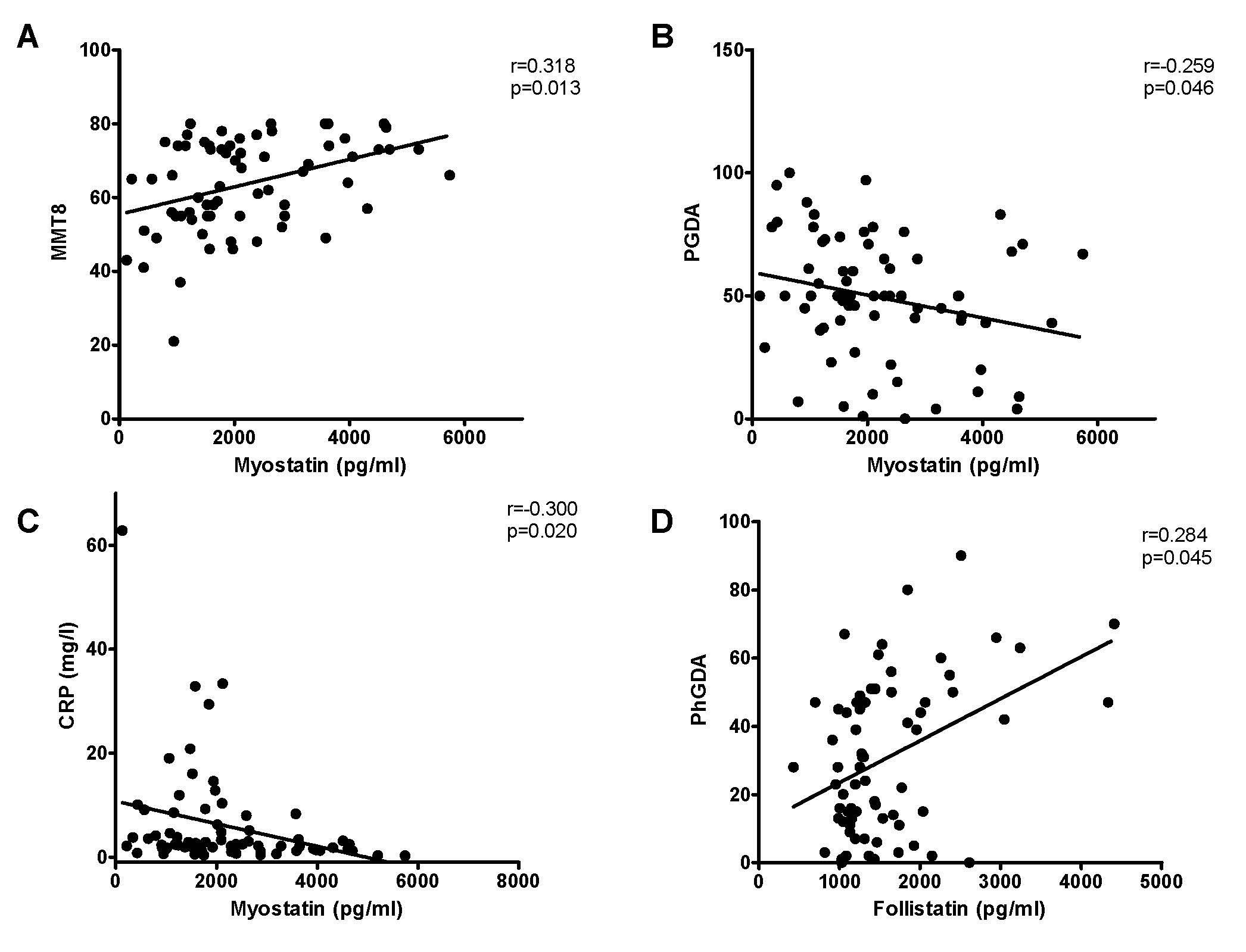Session Information
Session Type: Poster Session (Monday)
Session Time: 9:00AM-11:00AM
Background/Purpose: The aim of this study was to investigate myokines involved in muscle atrophy such as myostatin, follistatin and activin A, in idiopathic inflammatory myopathies (IIM). Recent findings show that rather than myostatin alone, the activin A-myostatin-follistatin system is believed to play an important role in musculoskeletal growth, development and aging. The myostatin biology known by now encourages considering its blocking therapy in IIM as the muscle weakness and atrophy persist in patients even after the suppression of inflammation.
Methods: A total of 94 patients with IIM and 155 healthy controls (HC) were enrolled in the study. Apart from serum samples taken during regular patients’ visits, 20 IIM patients and 21 HC underwent a muscle biopsy. Circulating concentrations of myostatin, follistatin, activin A and TGF-β1 were assessed by ELISA. The expression of myokines and associated genes involved in myostatin signalling pathway in muscle tissue was determined by real-time PCR using TaqMan® Gene Expression Assays.
Results: We report decreased levels of circulating myostatin (2024±1111 vs. 2647±792 pg/ml; p=0.0003) and increased follistatin (1542±564 vs. 1332±670 pg/ml; p=0.008) in IIMs compared to HC. Activin A levels were higher in IIM (394±142 vs. 334±132 pg/ml; p=0.013) compared to controls while no significant difference was observed for serum TGF-β1. Myostatin was significantly correlated to disease activity measures such as muscle disease activity (muscle DA) (r=-0.289, p=0.015) and manual muscle testing of 8 muscles (MMT8) (r=0.366, p=0.002). On the other hand, follistatin correlated positively with muscle DA (r=0.235, p=0.047). Gene expression analysis showed higher follistatin (p=0.040) and myostatin inhibitor FSTL3 (p=0.008) levels and lower expression of activin receptor type 1B (ALK4) (p=0.034), signal transducer SMAD3 (p=0.023) and atrophy-related E3 ligase atrogin-1 (p=0.0009) in IIM muscle tissue compared to controls.
Conclusion: The findings of this study contradict the expected pattern of activin A-myostatin-follistatin system in muscle wasting diseases by showing lower myostatin and higher follistatin in circulation and attenuated expression of ALK4, SMAD3 and atrogin-1 in skeletal muscle of patients with inflammatory myopathies, suggesting the existence of an internal mechanism aimed at reducing further loss of muscle proteins during myositis. Furthermore, we show that the activin A-myostatin-follistatin system disturbance is more profound in patients with more active disease.
Correlation coefficients and significance levels displayed in scatterplots were calculated by partial correlation analysis with correction for age, BMI and glucocorticoid dose.
MMT8 – Manual muscle testing of 8 muscles; PGDA – Patient’s global assessment of disease activity; CRP – C-reakctive protein; PhGDA – Physician’s global assessment of disease activity.
To cite this abstract in AMA style:
Vernerová L, Horvathová V, Kropáčková T, Vokurková M, Klein M, Oreska S, Kubinova K, Mann H, Spiritovic M, Storkanova H, Kryštůfková O, Tomcik M, Ukropec J, Ukropcová B, Vencovský J. Alterations in Activin A-Myostatin-Follistatin System Associate with Disease Activity in Inflammatory Myopathies [abstract]. Arthritis Rheumatol. 2019; 71 (suppl 10). https://acrabstracts.org/abstract/alterations-in-activin-a-myostatin-follistatin-system-associate-with-disease-activity-in-inflammatory-myopathies/. Accessed .« Back to 2019 ACR/ARP Annual Meeting
ACR Meeting Abstracts - https://acrabstracts.org/abstract/alterations-in-activin-a-myostatin-follistatin-system-associate-with-disease-activity-in-inflammatory-myopathies/

